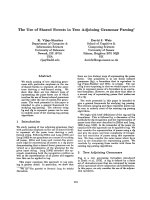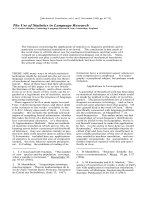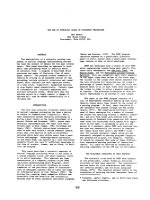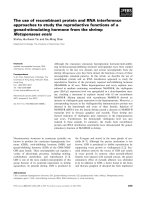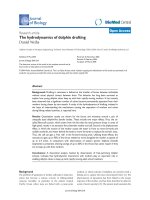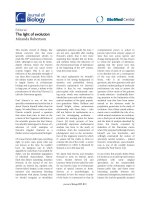Báo cáo sinh học: "The use of fixed effect models and mixed models to estimate single gene associated effects on polygenic traits" pot
Bạn đang xem bản rút gọn của tài liệu. Xem và tải ngay bản đầy đủ của tài liệu tại đây (699.33 KB, 13 trang )
Original
article
The
use
of
fixed
effect
models
and
mixed
models
to
estimate
single
gene
associated
effects
on
polygenic
traits
HB
Bentsen
G
Klemetsdal
Agricultural
University
of
Norway,
Department
of
Animal
Science,
N-1432
As
Norway
(Received
8
March
1989;
accepted
23
July
1991)
Summary -
Single
gene
associated
effects
on
polygenic
traits
may
often
be
confounded
with
the
effects
of
a
non-random
genetic
relationship
between
individuals
sharing
a
particular
allele
of
the
investigated
gene.
Two
different
statistical
models
are
suggested
to
separate
the
single
gene
associated
effects
from
the
remaining
additive
genotype:
a
fixed
effect
model
with
ancestor
variables
and
a
mixed model
with
random
effects
of
the
additive
genotypes
of
the
individual
animals
(individual
animal
model).
The
use
of
the
models
is
illustrated
by
an
example
from
an
experiment
with
the
chicken
major
histocompatibility
complex
(MHC)
gene
region.
single
gene
effects
/
fixed
effect
model / animal
model / chicken
/
major
histocom-
patibility
complex
Résumé —
L’utilisation
des
modèles
à
effets
fixes
et
des
modèles
mixtes
pour
estimer
des
effets
de
gènes
individuels
sur
des
caractères
polygéniques.
Des
effets
de
gènes
individuels
sur
des
caractères
polygéniques
sont
souvent
confondus
avec
des
effets
d’une
relation
génétique
non
aléatoire
entre
individus
partageant
un
allèle
étudié.
Deux
modèles
statistiques
différents
sont
proposés
pour
séparer
les
effets
associés
au
gène
unique
du
génotype
additif
restant:
un
modèle
à
effets
fixes
représentant
les
contributions
des
ancêtres
et
un
modèle
à
effets
aléatoires
des
génotypes
additifs
individuels
(modèle
individuel
animal).
L’emploi
des
modèles
est
illustré
par
une
expérience
impliquant
la
région
génique
du
complexe
d’histocompatibilité
chez
la
poule.
effet
de
gène
individuel
/
modèle
à
effets
fixes
/
modèle
animal
/
poule
/
complexe
majeur
d’histocompatibilité
*
Correspondence
and
reprints:
HB
Bentsen,
Institute
of
Aquaculture
Research
(AK-
VAFORSK),
c/o
NLH,
N-1432
As,
Norway
INTRODUCTION
The
possibilities
of
detecting
genetic
polymorphism
in
domestic
animals
by
analysing
gene
products
or
by
direct
DNA
analysis
are
steadily
improving.
The
utilization
of
this
kind
of
information
in
selection
programmes
or
by
naked
gene
transfer
techniques
is
dependent
on
an
increased
knowledge
of
single
gene
associ-
ated
effects
on
polygenic
traits.
Such
effects
are
often
analysed
by
direct
comparison
of
the
average
performance
of
individuals
grouped
by
their
genotype
for
the
poly-
morphic
gene.
However,
since
relatives
have
an
increased
probability
of
sharing
any
particular
allele,
such
groups
are
not
always
expected
to
be
randomly
related.
The
single
gene
associated
effects
may
then
be
confounded
with
the
effect
of
a
system-
atic
sampling
of
other
unidentified
genes
affecting
the
investigated
polygenic
trait.
The
problem
will
be
magnified
in
small,
closed
populations
of
animals
with
high
reproductive
rates.
The
obvious
solution
to
this
problem
will
be
to
restrict
the
anal-
ysis
to
comparisons
of
sibs
or
inbred
lines
segregating
for
the
polymorphic
gene.
This,
of
course,
also
sets
limits
to
the
type
of
material
that
may
be
analysed
and
to
the
efficiency
of
the
analysis.
The
need
for
statistical
models
that
may
separate
single
gene
associated
effects
from
the
remaining
genotype
of
any
individual
in
a
heterogeneous
population
is,
therefore,
obvious.
The
present
paper
describes
2
models
that
may
be
used
for
this
purpose.
Within
certain
limitations,
they
are
applicable
in
most
pedigreed
populations.
Individuals
from
several
generations
can
be
analysed
together.
It
should
be
noted
that
the
models
are
not
designed
to
study
the
nature
of
the
single
gene
associated
effects.
To
distinguish
between
direct
effects
of
the
investigated
gene
and
effects
caused
by
linkage
disequilibrium
with
other
genes
or
to
determine
linkage
distance,
appropriate
experiments
should
be
carried
out.
However,
if
the
investigated
material
can
be
divided
into
distinct
subpopulations,
applying
the
present
models
on
each
subpopulation
separately
will
often
result
in
variable
estimates
if
the
single
gene
associated
effects
are
caused
by
linkage
disequilibrium.
MODELS
FOR
ESTIMATION OF
SINGLE
GENE
ASSOCIATED
EFFECTS
If
a
random
genetic
relationship
is
assumed
between
individuals
sharing
the
same
genotype
for
the
investigated
gene,
then
the
single
gene
associated
effects
can
be
analysed
according
to
the
following
basic
model
of
fixed
effects.
where
I i!!.
is
the
polygenic
trait
performance
of
the
kth
individual
in
the
ith
non
genetic
fixed
effect
classification
with
the
jth
genotype
for
the
investigated
gene
a
is a constant
S,
is
the
effect
of
the
ith
non
genetic
fixed
effect
classification
(herd,
year,
season,
etc)
Gj
is
the
effect
of
the
jth
genotype
for
the
investigated
gene
Ci
ik
is
a
random
error.
Estimates
of
the
Gj
parameters
in
the
model
may
be
obtained
by
least
squares
means
analysis.
The
significances
of
the
contrasts
between
the
estimates
may
be
tested
according
to
standard
general
linear
models
procedures.
The
Gj
effects
reflect
the
total
effect
associated
with
the
two
alleles
constituting
the
genotype,
both
the
independent
effect
associated
with
each
allele
and
any
interaction
effects
between
them.
Direct
gene
action
may
not
be
distinguished
from
linkage
effects.
If
the
total
number
of
individuals
recorded
is
n,
the
number
of
non-genetic
fixed
effect
classifications
is
f,
and
the
number
of
genotypes
for
the
investigated
gene
is
f2 ,
Model
0
may
be
written
in
matrix
notation
as
follows:
where
Y
is
a
(n
x
1)
vector
of
ll j
k
performance
records
Xl
is
an
(n
x
f )
incidence
matrix
for
the
constant,
the
Si
effects
and
the
Gj
effects
( f
=
1
+
fl
+
f2)
bl
is
a
( f
x
1)
vector
including
the
constant,
the
Si
effects
and
the
Gj
effects
e
is
an
(n
x 1)
vector
of
random
errors.
As
pointed
out
previously,
a
random
genetic
relationship
within
each
Gj
group
may
normally
not
be
assumed,
and
the
Gj
estimates
according
to
Model
0
may
then
be
confounded.
Ancestor
model
To
avoid
the
confounding
effects,
the
model
should
be
extended
to
include
inde-
pendent
parameters
estimating
the
remaining
additive
genotype
affecting
the
poly-
genic
trait.
Such
independent
parameters
may
be
estimated
when
the
investigated
gene
shows
variation
within
family
lines
or
family
groups.
If
the
genetic
relationship
between
each
of
the
individuals
included
in
the
analysis
and
each
of
the
complete
set
of
ancestors
in
a
common
base
population
is
known,
the
basic
principles
of
several
general
linear
models
estimating
crossbreeding
parameters
(reviewed
by
Fimland,
1983)
may
be
applied.
The
present
model
is
modified
to
deal
with
individual
gene
contributions
rather
than
breed
contributions,
and
the
fixed
effects
of
these
contributions
are
regarded
as
correction
terms
rather
than
parameters
to
be
estimated.
The
extended
model
may
be
written
as
follows:
r
where
(3m
is
the
fixed,
additive
effect
of
genes
originating
from
the
mth
base
population
ancestor
r
is
the
number
of
base
population
ancestors
B
mij/,;
is
the
expected
proportion
of
the
total
genotype
of
the
kth
individual
contributed
by
the
mth
base
population
ancestor,
E
Bm
ij
k
=
1.0
for
each
k,
(m =
1, 2, , r).
The
Gj
effects
may
be
estimated
and
tested
according
to
the
same
standard
procedures
as
under
Model
0.
Model
1 may
be
written
in
matrix
notation
as
follows:
where
X2
is
a
(n
x
r)
relationship
matrix
of
Bmijk
values
showing
the
expected
genetic
relationship
between
each
of
the
recorded
individuals
and
each
of
the
base
population
ancestors.
b2
is
a
(r
x 1)
vector
of
(3
1
11
regression
coefficients.
Individual
animal
model
The
confounding
effects
of
the
remaining
additive
genotype
for
the
polygenic
trait
may
also
be
eliminated
in
a
mixed
model
including
the
random
effects
of
the
individual
additive
genotypes
of
the
recorded
animals.
The
use
of
an
individual
animal
model
to
estimate
single
gene
associated
effects
was
suggested
by
Kennedy
and
Schaeffer
(1990).
Basically,
this
model
may
be
written
as
follows:
where
Uk
is
the
random,
&dquo;single
gene
free&dquo;
additive
genetic
effect
on
the
polygenic
trait
in
the
kth
individual.
In
matrix
notation,
this
model
may
be
written
as
follows:
where
Z
is
an
(n
x
n)
incidence
matrix
for
the
individual
additive
genotypes
for
the
polygenic
trait
u
is
an
(n
x
1)
individual
additive
genotype
effect
vector
of
Uk
values.
It
has
been
shown
by
Henderson
that
the
fixed
effect
vector
(b
l)
and
the
random
effect
vector
(u)
may
be
obtained
by
computing
the
best
linear
unbiased
estimates
(BLUE)
for
the
fixed
effects
and
the
best
linear
unbiased
predictors
(BLUP)
for
the
random
effects.
If
all
animals
have
single
records,
the
radom
error
covariance
is
assumed
to
be
0
and
the
random
error
variance
is
equal
for
all
individuals,
the
following
mixed
model
equations
may
be
applied
(Henderson,
1973,
1977):
where
A
is
an
(n
x
n)
individual
additive
genetic
relationship
matrix
h2
is
the
heritability
of
the
investigated
trait
when
the
single
gene
associated
variation
is
not
included
in
the
additive
genetic
variance
component
(&dquo;single
gene
free&dquo;
heritability).
The
appropriate
heritability
may
be
obtained
from
variance
components
esti-
mated
from
the
equivalent
model
by
restricted
maximum
likelihood
(REML)
and
the
derivative
free
approach
described
by
Meyer
(1988,
1989).
To
ensure
maximum
precision
of
the
b1
and
u
solutions,
individuals
without
records
in
y
that
contribute
to
the
genetic
relationship
between
individuals
with
records
in
y
should
be
included
in
A.
The
extended
A
should
always
include
the
base
population
individuals
and
their
common
ancestors
during
the
last
preceding
generations.
If
the
total
number
of
individuals
with
and
without
records
in
the
analysis
is
n’,
the
dimension
of
the
extended
A
will
be
(n’
x
n’)
and
the
corresponding
dimensions
of
Z
and
u
will
be
(n
x
n’)
and
(n’
x 1).
BLUP
solutions
(u)
will
consequently
be
computed
for
all
animals,
including
individuals
without
records
in
y.
To
compute
the
least
squares
means
of
the
fixed
effects
under
Model
2
and
the
contrasts
between
them
and
to
test
the
significances
of
the
contrasts,
a
simplified
approach
may
be
applied.
The
complete
mixed
model
equations
may
be
condensed
by
absorbing
the
random
variables
(u)
into
the
fixed
effects
design
matrix
(XiX
l
).
This
condensed
( f
x
f )
matrix
may
then
be
applied
to
estimate
and
test
the
contrasts
according
to
standard
least
squares
procedures
(see
eg
Searle,
1982).
The
estimates
of
the
contrasts
between
the
Gj
effects
will
be
directly
comparable
with
the
contrasts
obtained
under
Model
0
and
Model 1.
However,
to
compute
least
squares
mean
estimates
of
the
Gj
effects
that
can
be
directly
compared
with
the
estimates
under
Model
0
and
Model
1,
the
average
BLUP
value
of
individuals
with
records
in
y
must
be
included
in
the
estimates.
This
will
require
the
solution
of
the
complete
set
of
mixed
model
equations
to
obtain
individual
BLUP
values.
Modifications
of
the
models
The
Gj
effects
in
the
models
may
be
decomposed
according
to
the
following
general
formula:
where
81’
is
the
average
linear
effect
of
the
pth
allele
of
the
investigated
gene
v
is
the
number
of
alleles
of
the
investigated
gene
AI,
is
the
frequency
of
the
pth
allele
carried
by
the
individual
(Ap
=
0,
1
or
2,
I: Ap = 2 for p = 1,2, ,v)
Î
is
the
regression
coefficient
for
the
general
effect
of
heterozygosity
in
the
investigated
locus
H
is
the
degree
of
heterozygosity
in
the
investigated
locus
(normally
H
=
0
or
1)
éq
is
the
regression
coefficient
for
the
qth
specific
combining
effect
of
two
.
different
alleles
of
the
investigated
gene
w
is
the
number
of
different
specific
combinations
of
two
different
alleles
C9
is
the
incidence
of
the
qth
specific
combination
of
two
different
alleles
of
the
investigated
gene
(C,
=
0
or
1,
!
Cq
=
0
or
1
for
q
=
1, 2, , w)
If
the
Gj
effects
in
the
models
are
substituted
according
to
the
formula
above,
the
contrasts
between
the
linear
effects
of
the
investigated
alleles,
the
general
effect
of
heterozygosity
and
the
contrasts
between
the
specific
combining
effects
of
the
investigated
alleles
may
be
evaluated
separately.
If
the
specific
combining
effects
are
assumed
to
be
negligible,
the
e9
Cq
elements
may
be
excluded
from
the
models.
The
number
of
single
gene
associated
estimates
may
then
be
reduced
compared
to
the
original
models.
This
reduction
may
be
important
if
a
large
number
of
unevenly
distributed
alleles
are
investigated
simultaneously
in
a
limited
number
of
experimental
animals.
The
parameters
of
this
reduced
model
may
be
estimated
with
a
higher
accuracy,
and
the
performance
of
any
particular
genotype
may
be
predicted
from
the 8
1’
and
the
-/
estimates,
even
if
the
genotype
is
missing
in
the
experimental
records.
PROPERTIES
OF
THE
MODELS
The
genetic
relationship
parameters
required
in
both
Models
1
and
2
may
be
generated
from
pedigree
records.
Several
generations
of
related
individuals
may
be
analysed
simultaneously.
In
Model
1,
the
pedigree
of
the
investigated
individuals
must
be
traced
back
to
a
common
ancestor
base
population.
In
many
cases,
the
parents
of
the
first
experimental
generation
may
be
regarded
as
the
base
population.
In
Model
2,
the
complete
genetic
relationship
matrix
between
all
investigated
individuals
should
be
generated.
In
most
cases,
this
will
require
pedigree
records
for
several
generations
of
ancestors
prior
to
the
first
investigated
generation.
In
addition
to
the
genetic
relationship
parameters,
the
covariance
between
relatives
is
determined
by
the
heritability
of
the
investigated
polygenic
trait.
In
Model
1,
the
realized
additive
genetic
effect
of
each
ancestor
genotype
is
utilized
to
obtain
the
(3
m
estimates.
Consequently,
(3
m
by
definition
estimates
the
&dquo;single
gene
free&dquo;
additive
genotype
of
the
base
population
ancestors
and
it
may
be
possible
to
obtain
a
kind
of
average
&dquo;single
gene
free&dquo;
heritability
estimate
based
on
the
variance
of
the
(3
m
estimates
if
the
phenotypic
variance
of
the
polygenic
trait
in
the
base
population
ancestor
is
known.
In
Model
2,
the
heritability
is
a
required
input
parameter.
The
use
of
a
a
priori
heritability
estimates
in
an
individual
animal
model
may
be
justified.
As
shown
in
the
example
in
the
present
paper,
the
fixed
effects
solutions
may
be
affected
if
the
difference
between
the
assumed
and
the
real
heritability
is
too
large.
Since
the
required
heritability
input
should
be
&dquo;single
gene
free&dquo;,
reliable
a
priori
estimates
may
not
be
available.
Kennedy
(1990)
concluded
that
the
heritability
may
then
be
estimated
from
the
experimental
records.
This
can
be
done
by
the
RENIL
approach
referred
to
earlier.
The
accuracy
of
the
(3m
estimates
according
to
Model
1
is
dependent
on
the
number
of
individuals
originating
from
each
of
the
base
populations
ancestors.
In
most
species,
the
number
of
first
generation
offspring
per
ancestor
dam
may
be
quite
limited.
Furthermore,
applying
Model
1
to
first
generation
offspring
only
may
cause
an
additional
problem
because
of
limited
segregation
of
the
investigated
gene
within
offspring
sharing
proportions
of
a
common
additive
ancestor
genotype.
The
required
genetic
composition
of
the
experimental
individuals
may
be
achievied
by
multiple
matings
of
the
base
population
ancestors
in
different
combinations,
by
recording
offspring
from
generations
later
than
the
first
one
or
by
pooling
several
generations
of
offspring.
If
possible,
the
mating
scheme
should
be
designed
to
ensure
genetic
ties
across
genotypes
for
the
investigated
gene.
Model
2
is
less
sensitive
to
this
type
of
problems
but
a
certain
degree
of
genetic
relationship
across
genotypes
for
the
investigated
gene
is
still
required
to
eliminate
the
confounding
effects.
In
Model
1,
the
error
variance
is
not
expected
to
be
constant
across
generations.
The
direct
offspring
of
the
base
population
ancestors
may
be
scored
without
error
for
the
B&dquo;,,i!!.
variables
(0
or
0.5).
In
the
successive
generations,
the
Bm
ij
k
variables
represent
the
expected
ancestor
gene
contributions
while
the
real
contributions
are
influenced
by
the
random
sampling
of
alleles
during
gamete
formation.
This
sampling
error
is
accumulated
as
the
number
of
generations
increases.
The
precision
of
the
estimates
according
to
Model
1
may
consequently
be
poor,
if
the
number
of
generations
between
the
ancestor
base
population
and
the
investigated
individuals
is
too
large.
The
error
variance
of
Model
2
is
not
influenced
by
such
generation
effects.
The
average
effect
of
selection
for
the
dependent
variable
may
be
adjusted
for
by
including
generation
effects
as
fixed
effects
in
Model
0
and
Model 1.
However,
the
effect
of
selection
on
the
(3m
estimates
according
to
model
1
may
vary
from
one
estimate
to
another
due
to
random
differences
in
the
realized
selection
intensities
in
the
gene
flow
from
different
base
population
ancestors.
This
will
violate
the
basic
assumption
that
the
(3n
effects
may
be
regarded
as
fixed
effects
across
generations.
A
similar
problem
may
arise
as
a
result
of
genetic
drift,
if
severe
bottle-necks
appear
in
the
gene
now
from
some
of
the
base
population
ancestors
to
any
of
the
offspring
generations.
Consequently,
selection
and
genetic
bottle-necks
should
be
avoided
when
applying
Model 1.
This
problem
will
be
less
important
if
Model
2
is
applied.
The
additive
genetic
effects
(V! )
are
then
regarded
as
random
effects
and
the
(V
k)
values
are
predicted
from
the
complete
genetic
variance-covariance
matrix
rather
than
from
ancestry
lines.
Any
genetic
trend
will
then
be
corrected
for
by
the
BLUP
values
(U! )
and/or
fixed
generation
effects,
depending
on
the
genetic
ties
between
the
recorded
individuals.
GENETIC
INTERPRETATIONS
OF
THE
SINGLE
GENE
ASSOCIATED
PARAMETERS
The
parameters
of
interest
in
the
models
are
estimated
by
the
Gj
effects.
The
total
effect
associated
with
each
of
the
genotypes
for
the
investigated
gene
on
the
polygenic
trait
is
computed.
Since
direct
gene
effects
may
not
be
distinguished
from
linkage
effects,
the
term
&dquo;gene
region&dquo;
will
be
applied
in
the
following
discussion,
indicating
that
the
polymorphic
gene
may
function
as
a
marker
gene.
The
Gj
estimates
will
contain
the
additive
effects
of
each
of
the
two
gene
regions
constituting
the
genotype,
the
general
and
specific
dominance
interactions
between
the
two
gene
regions
and
the
average
epistatic
effects
between
each
of
the
two
gene
regions
and
the
remaining
genotype
of
each
of
the
individuals
within
each
Gj
group.
The
epistatic
effects
are
true
single
gene
associated
effects,
but
they
may
be
difficult
to
reproduce
if
the
interacting
genes
are
variable,
unidentified
and
not
randomly
occurring
in
the
Gj
groups.
In
addition,
heterozygosity
in
the
investigated
locus
may
serve
as
a
marker
for
general
heterozygosity.
The
Gj
effects
may
then
be
confounded
with
general
heterosis.
This
may
be
checked
by
including
the
individual
coefficients
of
inbreeding
as
an
independent
variable
in
the
model.
The
parameters
of
interest
in
the
modified
models
are
estimated
by
the
6,,
!y
and e
Q
effects.
The
average,
linear
effects
associated
with
the
different
allelic
gene
regions
are
estimated
by
the
6p
effects.
The
total
linear
contribution
to
any
particular
genotype
may
be
calculated
by
adding
together
the
values
of
the
<
*
)p
estimates
for
each
of
the
two
gene
regions
constituting
the
genotype.
The
6p
estimates
will
reflect
the
additive,
single
gene
associated
effects.
The
general
effect
of
heterozygosity
is
estimated
by
the
q
effect.
The
estimate
reflects
the
average
deviation
from
the
6p
determined
genotype
in
heterozygous
individuals
and
is
influenced
by
the
general
dominance
interaction
between
the
different
gene
regions
and
by
the
general
deviation
from
linearity
caused
by
epistasis.
In
addition,
any
average
effect
of
the
investigated
gene
serving
as
a
marlcer
for
general
heterozygosity
will
be
included.
As
pointed
out
earlier,
this
may
be
checked
separately.
The
Eq
estimates
are
influenced
by
any
specific
combining
effects
in
the
different
heterozygous
combinations
of
the
investigated
gene,
including
specific
dominance
and
epistatic
interactions
involving
the
two
gene
regions.
AN
EXAMPLE
OF
THE
MODELS
IN
USE
The
ma,jor
histocompatibility
complex
(MHC)
in
birds
and
mammals
is
a
cluster
of
linked
genes
coding
for
major
cell
surface
antigens
and
is
known
as
the
B
complex
in
chiclcens.
MHC
associated
effects
have
been
shown
on
resistance
to
certain
diseases
and
on
immune
responsiveness.
The
association
between
the
MHC
gene
region
and
several
productivity
traits
in
laying
hens
was
investigated
in
an
experiment
at
the
Agricultural
University
of
Norway.
The
MHC
genotypes
of
the
experimental
birds
were
determined
by
serological
typing
at
the
Institute
of
Experimental
Immunology
in
Copenhagen
according
to
Simonsen
et
al
(1982).
MATERIALS
AND
METHODS
The
experiment
was
started
by
mating
individuals
with
heterozygous
combinations
of the
B13,
B19
and
B21
gene
regions
(MHC
haplotypes).
The
birds
were
taken
from
a
randomly
mated
control
population
(L
i)
and
from
a
selection
line
for
increased
egg
weight
body
to
weight
ratio
(L
z
).
The
selection
experiment
has
been
described
by
holstad
(1980).
The
number
of
parents
in
the
base
population
(r
in
Model
1)
was
28
in
Ll
and
80
in
Lz
but
since
each
dam
was
mated
to
only
one
sire,
the
number
of
ancestors
in
Model
1
may
be
reduced
to
the
number
of
dams
which
was
21
in
Ll
and
63
in
L2.
The
mating
procedure
was
repeated
with
heterozygous
individuals
from
the
first
and
the
second
generation
of
experimental
birds
to
produce
three
non-overlapping
generations
contributing
to
the
experiment
(f
l
=
3
in
all
models).
No
cross-mating
between
Ll
and
L2
was
allowed.
The
design
resulted
in
a
mixture
of
individuals
carrying
all
possible
combinations
of
the
3
MHC
haplotypes:
G,
=
B13/813,
G2
=
B19/BI9,
G3
=
B21/B21,
G4
=
B13/B19,
G5
=
B13/B21
and
G6
=
B19/B21
( f
z
=
6
in
all
models)
and
varying
fractions
of
ancestor
gene
contributions
crosslinking
the
MHC
genotypes.
The
total
number
of
birds
in
the
experiment
(n
in
all
models)
was
321
for
Ll
and
505
for
L2-
In
model
2,
the
relationship
matrix
(A)
was
generated
by
including
individuals
without
records
in
the
experimental
generations
and
all
common
ancestors
in
the
last
3
generations
prior
to
the
experiment.
The
total
number
of
birds
in
the
extended
A
(n’
in
Model
2)
was
636
in
Ll
and
761
in
La.
The
full
stored
coefficient
matrix
in
Model
2
was
solved
by
Gauss-Seidel
iteration.
The
solutions
were
considered
converged
when
the
average
value
of
the
product
1’A-
lu
was
<
0.001.
The
program
picks
some
generalized
inverse
of
the
coefficient
matrix
in
the
iteration
(Smith,
1982).
One
of
the
productivity
traits
recorded
was
the
laying
intensity
during
the
period
from
the
start
of
laying
until
58
weeks
eggs
of
age,
measured
as
the
number
of
eggs
laid
per
100
days.
The
association
between
laying
intensity
and
MHC
genotypes
was
analysed
according
to
Model
1
and
Model
2
for
both
11
and
Lz.
The
sensitivity
of
Model
2
to
changes
in
the
heritability
parameter
input
was
checked
by
applying
5
different
values
of
the
parameter
to
the
investigated
material
(h
2=
0.1, 0.3,
0.5,
0.7
and
0.9).
The
&dquo;MHC
free&dquo;
heritability
was
estimated
from
REML
variance
components
in
each
of
the
2
lines
separately
according
to
Model
2,
as
described
earlier.
RESULTS
AND
DISCUSSION
The
least
squares
means
of
laying
intensity
for
the
fixed
effects
of
NIHC
genotypes
(G
j
),
according
to
Model
0
and
Model
1
and
according
to
Model
2
over
the
entire
heritability
scale
are
shown
in
figure
1
for
Ll
and
figure
2
for
L2.
The
Gj
effects
according
to
Model
2
at
hz
=
0
are
by
definition
equal
to
the
Gj
effects
according
to
Model
0.
In
order
to
compare
the
results
from
Model
2
with
the
other
models,
a
&dquo;MHC
free&dquo;
heritability
value
must
be
chosen.
The
&dquo;MHC
free&dquo;
heritability
estimates
indicated
in
the
figures
were
based
on
the
REML
variance
components
shown
in
table
I.
points
may
be
made
from
the
results
shown
in
the
figures.
-
Considerable
confounding
effects
were
demonstrated
between
the
MHC
geno-
type
and
the
remaining
additive
genotype,
especially
in
Li.
Introduction
of
the
&dquo;1VIHC
free&dquo;
additive
genotype
in
the
model
affected
both
the
rank
and
the
magni-
tude
of
the
NIHC
associated
effects
(G
j
).
The
significance
of
the
ranking
of
the
Gj
effects
according
to
the
different
models
is
shown
in
table
II.
Applying
Model
0
to
the
present
material
would
lead
to
false
conclusions
according
to
table
II.
-
The
agreement
between
the
Gj
solutions
according
to
Model
1
and
Model
2
was
quite
good.
A
non-significant
re-ranking
was
indicated
for
G4
vs
G6
in
Ll
and
for
G3
vs
GS
in
L2
(table
II).
As
pointed
out
earlier,
Model
1
utilizes
the
realized
additive
genetic
effect
of
each
ancestor
genotype
to
obtain
the
1
3m
estimates,
while
Model
2
assumes
an
average
heritability
for
the
entire
material.
Since
MHC
genotypes
were
not
equally
distributed
over
ancestor
lines,
this
may
cause
some
differences
between
the
2
models
in
the
Gj
estimates.
The
standard
errors
of
the
contrasts
between
the
Gj
effects
in
pairwise
comparisons
with
G6
are
shown
in
table
III.
The
Gj
contrasts
were
estimated
with
a
higher
level
of
accuracy
under
Model
2
than
under
Model
1
(table
III).
This
did
not
affect
the
significance
of
the
ranking
of
the
Gj
effects
in
the
present
material
when
the
significance
level
was
fixed
at
0.01
(table
II).
However,
due
to
the
different
precision
of
the
two
models,
Model
2
may
discriminate
between
Gj
effects
which
will
not
differ
significantly
under
Model 1.
The
sensitivity
of
the
Gj
solutions
according
to
Model
2
to
changes
in
the
heritability
input
parameter
appeared
to
be
moderate.
In
the
present
material,
the
stability
of
the
Gj
estimates
seemed
to
be
quite
acceptable
if
the
heritability
input
was
varied
within
an
interval
of
0.2,
at
least
for
heritability
estimates >
0.1.
Good
a
priori
estimates
are
available
for
the
total
heritability
of
laying
intensity
(not
&dquo;MHC
free&dquo;)
in
a
related
material
(Kolstad,
1980).
The
heritability
was
reported
to
be
0.37.
As
may
be
seen
from
figures
1
and
2,
applying
this
heritability
to
the
present
material
would
not
change
the
conclusions
on
the
Gj
effects
very
much.
The
rank
of
the
MHC
genotypes
(G
j)
was
different
in
the
2
lines.
The
lines
orig-
inated
from
a
common
synthetic
population
formed
in
1973
(Liljedhal
et
al,
1979)
and had
only
been
separated
during
7
generations
when
the
present
experiment
was
started.
The
genetic
relationship
between
the
2
lines
was
consequently
quite
close.
The
MHC
associated
effects
may
still
be
different
in
the
two
lines
if
the
effects
were
caused
by
distant
linkage
between
the
MHC
gene
region
and
genes
affecting
laying
intensity.
The
observed
effects
would
then
be
temporary
effects
because
of
link-
age
breakdown.
The
increased
mangnitude
and
significance
of
the
MHC
associated
effects
in
Ll
compared
to
L2
is
consistent
with
the
linkage
hypothesis,
since
the
smaller
number
of
base
populations
ancestors
in
Ll
(28
compared
to
80)
increases
the
probability
of
linkage
disequilibrium.
REFERENCES
Fimland
E
(1983)
Methods
of
estimating
the
effects
of
heterosis.
Z
Tierz
Zuech-
tungsbiol
100,
3-8
Henderson
CR
(1973)
Sire
evaluation
and
genetic
trends.
In:
Proc
Anim
Breeding
and
Genetics
Symp
in
Honour
of Dr
Jay
L
Lush,
Blacksburg,
29
July,
1972.
ASAS
and
ADSA,
Champaign,
IL,
10-41
Henderson
CR
(1977)
Prediction
of
future
records.
In:
Proc
Int
Conf
Quantitative
Genetics,
Ames,
16-21
August
1976
(Pollak
E,
Kempthorne
0,
Bailey
TB,
eds)
Iowa
State
University
Press,
Ames,
IA,
615-638
Kennedy
BW
(1990)
Use
of
mixed model
methodology
in
analysis
of
designed
experiments.
In:
Advances
in
Statistical
Methods
for
Genetic
Improvement
of
Livestock
(Gianola
D,
Hammond
K,
eds)
Springer-Verlag,
Berlin,
77-97
Kennedy
BW,
Schaeffer
LR
(1990)
Reproductive
technology
and
genetic
evaluation.
In:
Advances
in
Statistical
Methods for
Genetic
Improvement
of
Livestock
(Gianola
D,
Hammond
K,
eds)
Springer-Verlag,
Berlin,
507-532
Kolstad
N
(1980)
Scandinavian
selection
and
crossbreeding
experiment
with
laying
hens.
III.
Results
from
the
Norwegian
part
of
the
experiment.
Acta
Agric
,Scand
30,
261-287
Liljedah
LE,
Kolstad
N,
Sorensen
P,
Maijala
K
(1979)
Scandinavian
selection
and
crossbreeding
experiment
with
laying
hens.
I.
Background
and
general
outline.
Acta
Agric
Scand
29,
273-286
Meyer
K
(1988)
DFRENIL -
a
set
of
programs
to
estimate
variance
components
under
an
individual
animal
model.
In:
Proc
of
the
ADSA
Workshop
in
Individual
Animal
Models,
Edmonton,
25-26
June,
1988
(Smith
GH,
ed)
J Dairy
Sci
71
(suppl
2),
33-34
Meyer
K
(1989)
Restricted
maximum
likelihood
to
estimate
variance
components
for
animal
models
with
several
random
effects
using
a
derivate
free
algorithm.
Genet
Sel
Evol 21,
317-340
Searle
SR
(1982)
Matrix
Algebra
Useful for
Statistics.
Wiley,
New
York,
408-415
Simonsen
M,
Crone
M,
Koch
C,
Hala
K
(1982)
The
MHC
haplotypes
of
the
chicken.
Immunogenetics
16,
513-532
Smith
SP
(1982)
The
extension
of
failure
time
analysis
to
problems
of
animal
breeding.
PhD
Diss,
Cornell
University,
Ithaca,
NY

